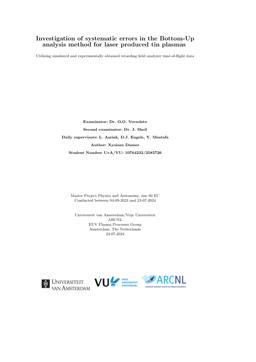2024-07-23
Investigation of systematic errors in the Bottom-Up analysis method for laser produced tin plasmas
Publication
Publication
State of the art integrated circuits are produced employing extreme ultraviolet (EUV) nanolithography. EUV photons are obtained from a plasma produced by high intensity laser illumination of tin microdroplets. Tin ions, which can damage costly optics within the EUV machine, are also emitted in this process. Knowledge about the charge state and energy spectra of ions emitted from laser produced plasma (LPP) is of great importance for industrial, high-volume nanolithography. LPP ion current is measured with retarding field analyzers (RFAs). RFA time-of-flight (ToF) data is analyzed using the so-called ‘Bottom-Up method’. Data is divided into energy bins containing known charge states, the use of several retarding voltages allows the calculation of cumulative spectra. Subtracting cumulative spectra yields charge-state-resolved ion energy spectra. Measuring with RFAs and the Bottom-Up method can introduce systematic errors, which influence the spectra and calculated energy. Simulations employing predetermined spectra have been performed to investigate the magnitude of these errors. A ToF resolution of 20 ns leads to an underestimated ion energy in simulations due to numerical instability. The underestimation is most pronounced at high kinetic energy thus and higher charge state. The energy regions with the greatest uncertainty in assigned charge state have been identified. These regions are those at the extrema of energy bins. Subdividing the analyzed energy bins and excluding the regions most impacted by the systematics from analysis leads to an improvement in recovered charge-resolved ion energy, with the deviation between input and output decreasing from 2.5 to 1.5 %. This improved analysis method has subsequently been applied on experimental data. The recovered total kinetic energy and momentum increase roughly 1 % and 0.5 % respectively, when compared to the original analysis method. A single experimental dataset has been analyzed using four ToF resolutions by downsampling. The recovered energy is 2.2 % lower using a ToF resolution of 20 ns when compared to a resolution of 2 ns . This decrease is mainly attributable to the decrease in assigned energy of the higher charge states in line with simulated spectra.
| Additional Metadata | |
|---|---|
| University of Amsterdam, UvA , VU University Amsterdam | |
| Y. Mostafa (Yahia) , D.J. Engels (Dion) , L. Assink (Luc) | |
| Organisation | EUV Plasma Processes |
|
Danser, X. (2024, July 23). Investigation of systematic errors in the Bottom-Up analysis method for laser produced tin plasmas. |
|

